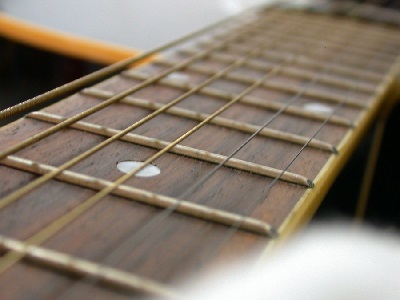Understanding the Notes On the Guitar Fretboard
 One of the most common problems beginner guitarists encounter is that they cannot find their way around the fretboard. Truth be told, you would be surprised by the number of guitarists who had been playing for years and still have issues in identifying notes on the individual strings.
One of the most common problems beginner guitarists encounter is that they cannot find their way around the fretboard. Truth be told, you would be surprised by the number of guitarists who had been playing for years and still have issues in identifying notes on the individual strings.
Here’s a quick test you can perform and I want you to be honest about it. Ask yourself whether you would hesitate for a split second in naming the note on the 8th fret of the G string or the 16th note on the A string.
If you are like the majority of the guitarists who have difficulties in naming the notes, this is the perfect opportunity for you to learn the fretboard and get a deeper understanding of it in this lesson.
First of all, let’s identify the notes of the 6 open strings on the guitar. The notes of a guitar in standard tuning are as follows: E B G D A E ( From 1st string [thinnest] to 6th string [thickest] ).
Notes Of The Open Strings

In music, notes are labeled alphabetically. There are a total of 12 different notes in music:
Notes Found in Music

On the guitar, each fret represents a specific note. The distance of one fret is a semi-tone and the distance of 2 frets is a whole tone. Let’s take the 6th string as an illustration. Starting on an open string E, the 1st fret (semi tone higher) would be an F note and the 2nd fret (whole tone higher) would be an F# note and etc. From the 12th fret onwards, the fretboard repeats itself at a higher octave.
Notes of the 6th String
Take a look at the diagram below. Do you notice that there are # and b symbols beside some of the alphabet? These are called sharps and flats respectively. A sharped note basically raises the note by a semitone whereas a flatted note lowers the note by a semitone. The A# note has the same pitch as the Bb note and there is really no difference in pitch between the 2 notes (except for technical naming purposes in sheet music).

Important Note: The notes (B and C) & (E and F) are always a semi-tone apart.
Now, Let’s Look at the Layout of the Entire Fretboard

I know it looks a little scary and daunting from the image above. The good news is that we had specially designed a warm up exercise to help you master all notes of the fretboard. All you need to do is to spend 3-5 minutes a day on this exercise and I guarantee you will have a complete understanding of the fretboard in no-time.
Now, you might wonder why having knowledge of the fretboard is so important? Well, this is a step towards mastering the guitar for any serious musician! By knowing the fretboard at the tip of your hands, you can easily derive chords, scales, make sense of guitar tablatures and translate your thoughts into actually playing!
If you want to build a strong musical foundation for better improvisation and making fewer mistakes in playing the wrong notes, you need to put in a little effort now in order to reap huge rewards a few months down the road.
Hands Down The Best Program Ever to Be Created
For the most effective step-by-step guitar method, we highly recommend Gibon’s Learn & Master Guitar course. This award winning DVD program is currently on a 3-day sale and you get to save $100 off the usual price today!
Click here to learn more details and purchase the course before this promotion ends…







Leave A Comment